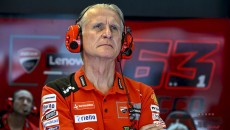When we talk about how much top-level sportsmen earn in any sport, we often imagine hyperbolic figures, especially because of what football has demonstrated to every other sport from this point of view. Even in MotoGP, salaries with six-zero figures are not lacking, but the general picture of the situation has changed a lot in recent seasons both in relation to what has happened due to Covid and for a whole series of other reasons which actually have very little or nothing to do with Covid.
To make an analysis of the current situation, however, a premise has to be made, which is absolutely necessary. Each manufacturer involved in MotoGP has an overall budget that is needed to cover the costs of an involvement that is certainly not cheap. With that budget you have to pay the costs of designing and developing a motorcycle, those of travel, the salaries of the engineers and technicians and obviously the salaries of the riders. As always, even in this case we often have to make do with what you’ve got, with budgets that must be best managed by managers to prevent excessive spending in a certain area from having such a decisive impact that you have to give up on others.
You can decide to pay a rider 10 million euros per season, but obviously that money will no longer be available to pay for any developments in the wind tunnel, or the investments needed to develop and build a new chassis. Maybe a rider who earns a lot, manages to solve the problems in any case and bring home the result and in this Marquez set the trend between 2017 and 2019, when on a Honda clearly less competitive than the Ducati he regularly beat everyone. According to the data reported by our Motorsport.com colleagues, the situation has changed in an interesting way, above all by virtue of the decisions made upstream by the managers of the various manufacturers, who have often taken different paths than in the past.
In 2018, the sum of the salaries was 58 million. Today we are at 47
One figure is clear, namely the total salary of the riders involved in MotoGP which in 2018 was close to 58 million euros. A figure to be shared among the 24 drivers on the grid, with obviously one rider alone who was able to shift the balance. Just think that champions like Jorge Lorenzo, Valentino Rossi and Dani Pedrosa were still racing that year to understand what we're talking about. If we bring that figure back to today, we will see that it has been greatly reduced with a possible figure of about 47 million representing the total salaries of the 2022 season.
But why is this data so different? Of course, the crisis has had a significant impact and many riders had to give up on high salaries due to the situation everyone was faced with. The most expensive retainer is that of Marc Marquez, who grabbed a contract from Honda that is rumoured to be around 15 million per season between 2020 and 2024. If we think that Marc also had to give up on all of 2020 and a part of 2021, it is easy to think that the incidence is too high. But the reality is that without Marc, Honda would have gone through an even darker period in these two seasons, so the multimillion-dollar cheque to be paid to Marc, a rider who undoubtedly makes the difference, is more than welcome.
Honda has made this decision and is sticking with it, but the others do things differently and this change of course justifies that drop of almost 20% in the total amount of the salaries. Let's look at Ducati and its policy from this point of view over the last few seasons. Already with Valentino Rossi it was thought that the Doctor alone could bring the title back to Borgo Panigale after the Stoner era. Big mistake, as we all know, and above all it was a mistake made again with Jorge Lorenzo. The Spaniard picked up a pharaonic retainer in 2017 which included a salary of 25 million euros in two seasons. The 12.5 in 2017 is probably among the worst money spent by Ducati in MotoGP, while in 2018, just when that investment was starting to make sense, it was decided to torpedo Lorenzo to promote Petrucci. In the middle, Dovizioso, thanks to an amazing 2017, managed to guarantee himself an important fee from the manufacturer.
Ducati has focused on young riders and saved resources for development
Fast forward to 2021 to witness a total change of course. Miller and Bagnaia arrived in the official team and their fees are not even remotely comparable to those of the pairing in 2018, but the results certainly were not lacking. Ducati decided to invest in young riders rather than relying on veterans with a higher salary and probably this choice also allowed it to invest more in development and to be able to cope with the commitment to supply eight bikes on the grid in 2022. A strategy that, as seen above all in the final part of 2021 seems absolutely spot-on.
KTM went in a similar way, following the experiment with Zarco; that is, after opting to hire a top rider to try to make the RC16 fly, it went back on its steps by putting on the track a decidedly younger and more aggressive quartet of riders. Oliveira has shown champion class and Binder is always concrete and probably still has potential to express. Add to this pair, the Tech3 duo, with Fernandez already going strong in Sepang and you will have another answer. KTM has also moved into the market of technicians and managers, hiring Fabiano Sterlacchini and Francesco Guidotti, two former members of the Ducati family who have certainly strengthened the entire team. The Mattighofen company also has a certain Dani Pedrosa on the payroll in the role of tester and probably his salary will not be exactly cheap.
The situation of Suzuki and Aprilia, on the other hand, is slightly different. The Hamamatsu brand has always focused on young riders and the pairing chosen at the beginning of 2020 followed this strategy. With Mir as a rookie and Rins as a still young but already experienced rider, they had picked up a very interesting and above all cheap couple of riders. However, 2021 was the year of the title and Mir obviously made some major requests that were accepted. An adjustment was also offered to Rins and the result is that one of the probably most interesting pairs from the point of view of quality / price (and forgive the pun worthy of the worst supermarket leaflet) has turned into a heavy weight on the balance sheet of the team. The result was seen in 2021, with the two riders who often attacked Suzuki for the few developments brought to the races and for a gap they accumulated with respect to their increasingly competitive rivals.
Aprilia and Suzuki: big retainers, not the best balance
For its part, Aprilia has wanted to reward Aleix Espargarò over the years, often increasing his retainer and acknowledging him in the role of leader. Now his salary will probably be around 4 million euros per season, but while this figure was pretty light at the beginning of 2021, with Iannone out of action because of his disqualification for doping, 2022 opens with very different perspectives. Maverick Vinales had an annual salary of 8 million for Yamaha, one of the most expensive riders on the grid. Certainly in Noale they have not offered him the same figure, but it is difficult to imagine that Vinales can earn even less than Aleix Espargarò. A total that could therefore be around 8 million and a bike that, despite having made enormous strides forward in 2021, still has to improve a lot to become a winner. Jorge Lorenzo himself told us in September that in Aprilia they had chosen not to hire a champion like him, who obviously wouldn't go to Noale for little money.
Yamaha hit the jackpot from a certain point of view with Vinales leaving mid-season. The Spaniard had a salary perhaps even higher than that of Fabio Quartararo, who in turn is knocking on the cash tills today for the renewal. The Frenchman, on the strength of the title he won in 2021, wants a salary comparable to that of Marc Marquez, but the Iwata manufacturer is facing a huge problem. Fabio won the title, but Ducati's improvement is there for all to see and the fact that the M1 suffers from a technical gap is clear for all to see. The choice would therefore be between two possibilities.
One would mean satisfying a rider like Quartararo, running the risk of running out of the budget necessary to develop the M1 and therefore counting only on his talent. The other way would instead be even more 'risky', that is to accept the idea of losing Fabio in order to have the necessary resources to develop the M1 properly so as not to need a phenomenon to see it get on the top step of the podium. On the other hand, in Yamaha there is Morbidelli, who in 2020 had finished a magnificent season in second place on a bike that was not very up-to-date, but very well sorted.
In short, there is a huge spectrum of arguments that have influenced the cap in rider retainer fees. Many managers are choosing to focus on young riders rather than veterans, but in general it seems that the new trend is to grant a less expensive starting salary, then tying a large chunk of this salary to the results on the track. As Cecconi from Aruba once said when Bautista was dominating on the Panigale V4 in SBK at the beginning of 2019: "Every time Alvaro wins, we know the cheque gets bigger, but we're happy about it."











